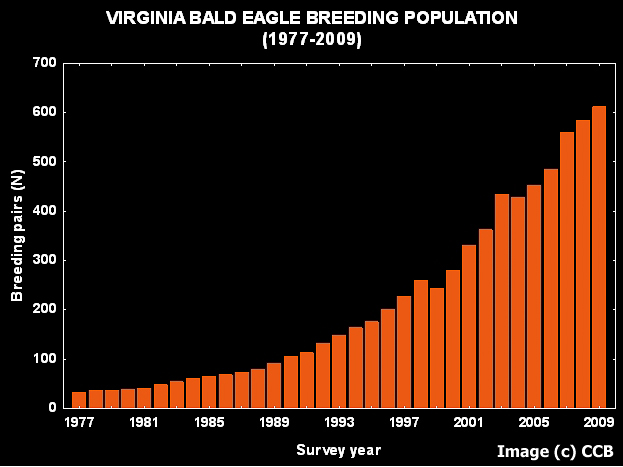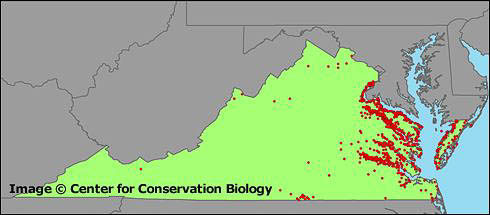Historic Bald Eagle Breeding Population
The Virginia breeding population of Bald Eagles is part of the broader breeding population within the Chesapeake Bay region (VA, MD, DE, and portions of WV, PA, and NJ). This regional population is geographically isolated from other breeding populations along the Atlantic Coast and elsewhere throughout North America. The dynamics and ecology of this population reflect characteristics of the entire region.
No specific estimates of the Chesapeake Bay Bald Eagle population are available prior to the early 1900s. However, given the high productivity of Bay waters and the availability of extensive shallow-water foraging areas, it has been speculated that prior to European settlement the Chesapeake Bay may have supported one of the densest breeding populations of Bald Eagles outside of Alaska. By applying breeding densities from Alaska to the 13,000 km of Chesapeake shoreline, Fraser et al. (1996) suggest that the pristine Chesapeake may have supported in excess of 3,000 breeding pairs of Bald Eagles (approximately half of which would have been in Virginia waters). This estimate is of course speculative but does reflect the extensive shoreline system and high productivity of the Bay. A more recent investigation within the Virginia portion of the Bay (Watts et al. 2003) shows significant spatial variation in colonization rates and breeding density that suggests carrying capacity varies throughout the lower Bay. One implication of these results is that the initial carrying capacity of the Bay may have been approximately half of that projected by the Fraser et al. (1996) study.
The first recorded survey of Bald Eagles in the Chesapeake Bay was a ground survey conducted by Bryant Tyrell for the Audubon Society in 1936 (Tyrrell 1936). Tyrell’s survey covered approximately 25% of the available habitat within which he estimated 150-200 nesting pairs (although he actually documented only 71 nests). This survey has been used to project that the Chesapeake Bay population was between 600 and 800 breeding pairs at this time (Abbott 1978, Byrd et al. 1990).
Breeding Population Decline
There are no records during the early phases of the Virginia Bald Eagle population decline. Many factors (e.g. land clearing, hunting and collecting, overfishing, market hunting for waterfowl, land development) likely contributed to declines in the population prior to and after the Tyrell surveys. However, the decline in the Chesapeake Bay Bald Eagle population was evident to the ornithological community by the mid-1950s (Abbott 1957, 1959). This time period coincides with parallel observations in Florida that were hypothesized by Broley (1957, 1958) to be caused by the widespread use of the biocide DDT. DDT and several related compounds came into widespread use as pesticides in the mid-1940s. We now know that the primary cause of the most recent and deepest phase of the population decline was the presence of DDT and its metabolites DDD and DDE in the Bald Eagle’s food chain (Wiemeyer et al. 1972, 1984, Byrd et al. 1990). Residue levels of several organochlorine pesticides found in eggs from the Chesapeake Bay Bald Eagle population in the years 1973-1979 were some of the highest for any Bald Eagle population in the United States (Wiemeyer 1984, Byrd et al. 1990). Analysis of carcasses during this time period indicated that this regions population was one of the most contaminated populations in the United States (Byrd et al. 1990).
The first aerial survey of eagle nests in the Chesapeake Bay was conducted in 1962 (Abbott 1963). The survey included approximately twice the land area covered by Tyrell in 1936. Survey results suggested that about 150 breeding pairs of eagles remained in the Chesapeake Bay in 1962 (Abbott 1978). Annual aerial surveys continued to document a decline until the population reached an estimated low of 80-90 pairs in 1970 (Abbott 1978).

Virginia Bald Eagle Breeding Population 1977-2009.
Breeding Population Recovery
From 1977 to the present, government agencies, conservation organizations, and researchers have collaborated to survey the Chesapeake Bay population. Population growth has been exponential over this time period with an overall ten-fold increase in breeding pairs. Annual aerial surveys began to reveal a gradual recovery of the Bald Eagle population in the late 1970s. By 1985, the Chesapeake Bay supported more than 120 eagle territories. By 1993, this number had increased to more than 300 territories. In 2003, the population included 773 occupied territories in Virginia and Maryland combined (Watts and Byrd 2003, Therres unpublished data). This increase has been exponential with an average doubling time of just over 8 years. The population has now reached levels estimated from the Tyrrell survey conducted prior to the introduction of DDT. The Chesapeake Bay population reached the size threshold for “downlisting” in 1988 and for “delisting” in 1992.

Map of active bald eagle nests surveyed in 2010 – the 55th consecutive Annual Bald Eagle Survey of Virginia. 900 nest structures were surveyed, and more than 680 breeding pairs produced more than 880 chicks.
A reproductive rate of 0.7 chicks/breeding attempt has been believed to represent the threshold for population maintenance for Bald Eagles (Sprunt et al. 1973). A considerably higher reproductive rate of 1.1 chicks/breeding attempt was set as the recovery goal for the Chesapeake Bay population (Byrd et al. 1990). The reproductive rate documented by Tyrrell in 1936 was nearly 1.5 chicks/breeding attempt. Documented rates for the Chesapeake Bay population reached an all-time low of 0.2 chicks/breeding attempt in 1962 (Abbott 1963). Productivity showed a steady increase throughout the late 1960s and early 1970s, reaching projected maintenance levels by the mid-1970s.
Text above is an excerpt from: Watts, B. D. 2005. Virginia Bald Eagle conservation plan. Center for Conservation Biology Technical Report Series, CCBTR-05-06. College of William and Mary, Williamsburg, VA. 52 pp.
